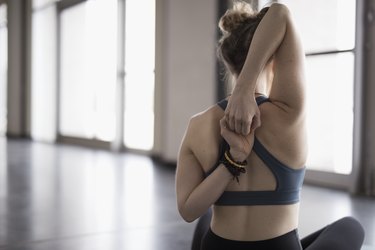
Everything from sitting in front of a computer for too long to incorrectly throwing a ball could affect the shoulder, and sometimes too much strain can result in a torn labrum. Depending on the type of tear, different treatments are available including torn labrum exercises after or in lieu of surgery.
What Is a Labrum Tear?
Video of the Day
First, what is the labrum? According to Johns Hopkins Medicine, it is a type of cartilage located in the shoulder joint. It's important to note that there are two types of cartilage: articular, white cartilage on the ends of bones, and the labrum, which is more rigid and fibrous. The labrum functions as a way to deepen the shoulder socket, so that everything stays in place. The labrum also helps attach other structures or tissues around the joint.
Video of the Day
There are many forms of labrum tears, so it's important to discuss with your physician the type of tear that you have:
Type 1: The labrum is torn completely off the bone.
Type 2: Tearing within the labrum itself.
Type 3: A tear where the biceps tendon attaches to the upper end of the socket (the abbreviation for this injury is a SLAP lesion).
How Are Labrum Tears Treated?
The treatment you get depends on the type of tear you have. Tears caused by instability of the shoulder, subluxation or dislocations, call for the labrum to be reattached to the rim of the socket. This can be done with arthroscopic techniques or an incision on the front of the shoulder.
If the labrum is frayed, treatment may not be necessary, though if there is a large tear, the torn area should be trimmed, repaired or cut out.
SLAP lesions may just need to be trimmed or reattached to the top of the socket. This can be done using arthroscopic surgery.
Torn Labrum Exercises Post-Surgery
After surgery for a torn labrum, your doctor might prescribe gentle range-of-motion exercises as part of the shoulder labral tear rehab protocol. Zero to two weeks after surgery, you can do the pendulum exercises, which is when you bend over at the waist and let your arm hang down, swinging it gently in small circular motions. Other exercises, recommended by Massachusetts General Hospital, include:
- Shoulder shrug: Shrug shoulders in an upward movement.
- Shoulder blade pinches: Pinch shoulder blades backward and together
- Isometric internal and external rotation: While facing the corner of a wall, keep your elbow against your side and hold your forearm at a right angle to your arm. Place the palm against the wall with the thumb facing up (for internal rotation) or the back of the hand against the wall with the thumb facing up (for external rotation). Pull or push against the wall. Hold for five seconds.
- Ball squeeze: Squeeze a rubber ball or tennis ball and hold for five seconds.
- Supine passive arm elevation: Lying on your back, hold the injured arm at the wrist with the opposite hand. With the opposite arm, lift the injured arm upward, then slowly lower it back down.
- Behind-the-back internal rotation: Sitting in a chair or standing, position the hand of the operated arm behind your back and use the opposite hand to help lift the other hand higher. Hold for ten seconds, then repeat.
Torn Labrum Exercises Without Surgery
If surgery isn't required, your doctor may recommend physical therapy to treat your torn labrum. ACE Physical Therapy & Sports Medicine Institute says your physical therapy will likely focus on exercises that strengthen the rotator cuff muscles. There will also be exercises to strengthen the shoulder blade stabilizing muscles and increase the flexibility of the shoulder joint.
Physical therapy exercises will include strengthening and stretching exercises. Examples of stretching exercises from MedlinePlus include:
- Stretching the back of your shoulder
- Wall stretches
- Anterior shoulder stretch
- Hand up your back stretch (anterior shoulder stretch)
- Pendulum exercises
Exercises to strengthen your shoulder include:
- Wall push-ups
- Isometric shoulder exercises
- Internal and external rotation exercises using a band
- Shoulder blade retractions (with and without tubing)
- Arm reach
Read more: Exercises for Shoulder Popping
Exercises to Avoid
Generally, athletes can begin doing sports-specific exercises 12 weeks after surgery, though it will be about six months before the shoulder is fully healed. But cases vary in terms of severity, and it may be difficult to predict exactly when someone will be able to go back to sports and activities. According to Johns Hopkins Medicine, doing contact sports will increase the chance of shoulder injury after labrum repair.